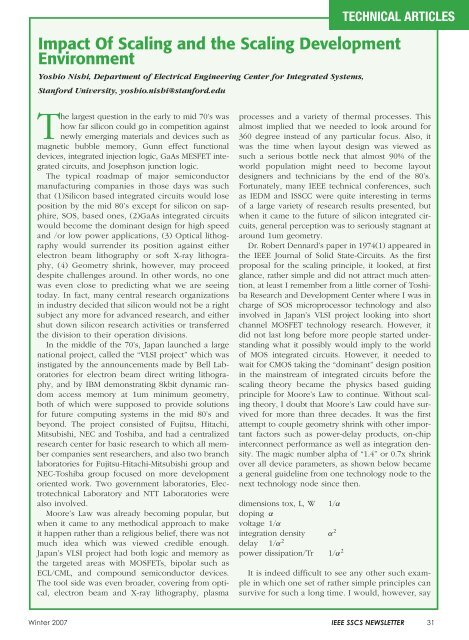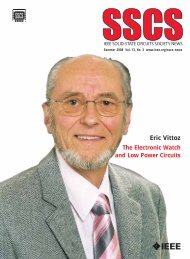The Impact of Dennard's Scaling Theory - IEEE
The Impact of Dennard's Scaling Theory - IEEE
The Impact of Dennard's Scaling Theory - IEEE
- TAGS
- scaling
- www.ieee.org
You also want an ePaper? Increase the reach of your titles
YUMPU automatically turns print PDFs into web optimized ePapers that Google loves.
<strong>The</strong> largest question in the early to mid 70’s was<br />
how far silicon could go in competition against<br />
newly emerging materials and devices such as<br />
magnetic bubble memory, Gunn effect functional<br />
devices, integrated injection logic, GaAs MESFET integrated<br />
circuits, and Josephson junction logic.<br />
<strong>The</strong> typical roadmap <strong>of</strong> major semiconductor<br />
manufacturing companies in those days was such<br />
that (1)Silicon based integrated circuits would lose<br />
position by the mid 80’s except for silicon on sapphire,<br />
SOS, based ones, (2)GaAs integrated circuits<br />
would become the dominant design for high speed<br />
and /or low power applications, (3) Optical lithography<br />
would surrender its position against either<br />
electron beam lithography or s<strong>of</strong>t X-ray lithography,<br />
(4) Geometry shrink, however, may proceed<br />
despite challenges around. In other words, no one<br />
was even close to predicting what we are seeing<br />
today. In fact, many central research organizations<br />
in industry decided that silicon would not be a right<br />
subject any more for advanced research, and either<br />
shut down silicon research activities or transferred<br />
the division to their operation divisions.<br />
In the middle <strong>of</strong> the 70’s, Japan launched a large<br />
national project, called the “VLSI project” which was<br />
instigated by the announcements made by Bell Laboratories<br />
for electron beam direct writing lithography,<br />
and by IBM demonstrating 8kbit dynamic random<br />
access memory at 1um minimum geometry,<br />
both <strong>of</strong> which were supposed to provide solutions<br />
for future computing systems in the mid 80’s and<br />
beyond. <strong>The</strong> project consisted <strong>of</strong> Fujitsu, Hitachi,<br />
Mitsubishi, NEC and Toshiba, and had a centralized<br />
research center for basic research to which all member<br />
companies sent researchers, and also two branch<br />
laboratories for Fujitsu-Hitachi-Mitsubishi group and<br />
NEC-Toshiba group focused on more development<br />
oriented work. Two government laboratories, Electrotechnical<br />
Laboratory and NTT Laboratories were<br />
also involved.<br />
Moore’s Law was already becoming popular, but<br />
when it came to any methodical approach to make<br />
it happen rather than a religious belief, there was not<br />
much idea which was viewed credible enough.<br />
Japan’s VLSI project had both logic and memory as<br />
the targeted areas with MOSFETs, bipolar such as<br />
ECL/CML, and compound semiconductor devices.<br />
<strong>The</strong> tool side was even broader, covering from optical,<br />
electron beam and X-ray lithography, plasma<br />
TECHNICAL ARTICLES<br />
<strong>Impact</strong> Of <strong>Scaling</strong> and the <strong>Scaling</strong> Development<br />
Environment<br />
Yoshio Nishi, Department <strong>of</strong> Electrical Engineering Center for Integrated Systems,<br />
Stanford University, yoshio.nishi@stanford.edu<br />
processes and a variety <strong>of</strong> thermal processes. This<br />
almost implied that we needed to look around for<br />
360 degree instead <strong>of</strong> any particular focus. Also, it<br />
was the time when layout design was viewed as<br />
such a serious bottle neck that almost 90% <strong>of</strong> the<br />
world population might need to become layout<br />
designers and technicians by the end <strong>of</strong> the 80’s.<br />
Fortunately, many <strong>IEEE</strong> technical conferences, such<br />
as IEDM and ISSCC were quite interesting in terms<br />
<strong>of</strong> a large variety <strong>of</strong> research results presented, but<br />
when it came to the future <strong>of</strong> silicon integrated circuits,<br />
general perception was to seriously stagnant at<br />
around 1um geometry.<br />
Dr. Robert Dennard’s paper in 1974(1) appeared in<br />
the <strong>IEEE</strong> Journal <strong>of</strong> Solid State-Circuits. As the first<br />
proposal for the scaling principle, it looked, at first<br />
glance, rather simple and did not attract much attention,<br />
at least I remember from a little corner <strong>of</strong> Toshiba<br />
Research and Development Center where I was in<br />
charge <strong>of</strong> SOS microprocessor technology and also<br />
involved in Japan’s VLSI project looking into short<br />
channel MOSFET technology research. However, it<br />
did not last long before more people started understanding<br />
what it possibly would imply to the world<br />
<strong>of</strong> MOS integrated circuits. However, it needed to<br />
wait for CMOS taking the “dominant” design position<br />
in the mainstream <strong>of</strong> integrated circuits before the<br />
scaling theory became the physics based guiding<br />
principle for Moore’s Law to continue. Without scaling<br />
theory, I doubt that Moore’s Law could have survived<br />
for more than three decades. It was the first<br />
attempt to couple geometry shrink with other important<br />
factors such as power-delay products, on-chip<br />
interconnect performance as well as integration density.<br />
<strong>The</strong> magic number alpha <strong>of</strong> “1.4” or 0.7x shrink<br />
over all device parameters, as shown below became<br />
a general guideline from one technology node to the<br />
next technology node since then.<br />
dimensions tox, L, W 1/α<br />
doping α<br />
voltage 1/α<br />
integration density α 2<br />
delay 1/α 2<br />
power dissipation/Tr 1/α 2<br />
It is indeed difficult to see any other such example<br />
in which one set <strong>of</strong> rather simple principles can<br />
survive for such a long time. I would, however, say<br />
Winter 2007 <strong>IEEE</strong> SSCS NEWSLETTER 31




